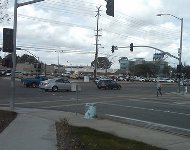9/3/2009
California: Costa Mesa Red Light Cameras Increased AccidentsThe total number of accidents increased where red light cameras were installed in Costa Mesa, California.

The total number of accidents increased at Costa Mesa, California intersections where red light cameras were installed, according to a city council report released on Tuesday. Since its inception in July 2003, the automated ticketing program has rewarded the city, county and state governments with millions in revenue. Nestor Traffic Systems (NTS), the bankrupt company in charge of the program, also shares in the bounty. Last year, for example, Nestor mailed $2,486,944 worth of the $436 traffic tickets.
The city report did not provide a complete analysis of results at every monitored intersection throughout the past six years. Instead, the report cherry-picked data from just two intersections, Harbor Boulevard and Bristol Street and Bristol Street and Anton Boulevard. It then chose four intersections without cameras and compared their performance between 2001 to 2003 -- before cameras -- and 2006 to 2008 -- after cameras. Even with cherry-picked locations, the total number of accidents increased 13 percent while the camera-free intersections experienced a 5 percent decrease. Rear end collisions also jumped 20 percent with cameras and dropped 10 percent without, a finding consistent with a number of independent studies of the effects of red light camera use (view studies).
"Rear end collisions usually increase due to some motorists braking quickly in anticipation of the red light camera activation, while the motorist directly behind does not react in time," Police Sergeant Rob Sharpnack wrote in a memo to the council. "The increase in rear end collisions accounts for the increase in total collisions."
The camera intersections reported a 15 percent reduction in the number of times police recorded an "injury collision," although the British Medical Journal has suggested that police officers in the UK underreport injuries so that camera programs would appear more effective in government reports.
Regardless of the city's assertions regarding the cameras' effectiveness, the city is not convinced about the effectiveness of Nestor in running the program in light of the company's recent financial troubles.
"Over the last six months, the Costa Mesa red light camera program administrator has called NTS on average two to three times per week to address problems with the system including performance issues, billing errors, inaccurate record keeping, yellow phasing problems and computer network issues," Sharpnack wrote. "It has been increasingly more difficult to speak to a live person at NTS as the company has decreased the size of its staff."
The problems are especially acute since Costa Mesa, like most cities across the country, exercises no oversight over the ticketing process. At Newport Boulevard last year, for example, the police believed the camera was not functioning properly. The agency had no means of independently verifying proper operation, so it placed a phone call to Nestor. The private company assured the police department that the camera was working just fine. Only after seeing no tickets in the monthly billing statements did the police know for sure that the camera in fact had not been working at all. The department was then able to solve its primary concern, assuring it would receive a refund for Nestor's monthly operational charge at that intersection.
Costa Mesa has also faced significant legal difficulty over the past several years. In 2005, the city lost a major court battle when the California Supreme Court declined to overturn a decision slamming the city for ignoring a state law regarding red light camera warning periods. The city was also caught issuing tickets at an intersection with an illegally short yellow time.
The police department recommended that the city council consider returning to traditional enforcement with live police officers.
"This greatly increases the number of traffic stops with officers enforcing all moving violations, equipment violations and registration violations," Sharpnack wrote. "Every available traffic officer participates daily not only to enforce against violating motorists, but to provide a high visibility to gain the attention of passing motorists as well to encourage safe driving habits."
A copy of the memo is available in an 80k PDF file at the source link below.


